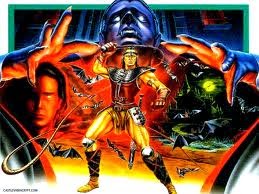I've started the series at a very young age, and it was one of the very first video games I ever played; along with Megaman, on my Nintendo Gameboy. (My very first Castlevania game being Castlevania II: Belmont's Revenge on the Nintendo Gameboy)
 |
| This is the Japanese boxart, which is far better than the US boxart of the game |
Here's a short review of the game, with some gameplay footage for you guys to see how the game looks like on the Nintendo Gameboy. :)
Then, after years of being handed off from one game development team to another, the series finally finds universal acclaim... and a face to carry the series forward. That face, was Koji Igarashi (fondly called by fans as IGA or IGA-san). And his claim to fame was the game that would forever place Castlevania in the minds of gamers around the world; Castlevania: Symphony of the Night.
By fusing exploration elements and an interlocking map system from Nintendo's game "Metroid", basic RPG elements mostly found on JRPGs, and Castlevania's distinct look and feel, Symphony of the Night elevated the series from relative niche obscurity, into universal acclaim in the gaming world. Alot of gamers fondly remember the game, being their first Castlevania game that they played and cherished, having alot of fond memories with the said game. I mean most gamers (specially those who grew up in the Playstation era) remember this iconic exchange between Count Dracula and Richter Belmont:
 |
| IGA's Castlevania Timeline (Click to enlarge) |
However, the tale would be left largely unfinished, as IGA suddenly finds himself losing the supervision duties of Castlevania. Konami (the publisher of the series), suddenly announces that the series will be turned over to a different development team.
Enter MercurySteam.
At first I was slightly nervous of the prospect of a new team handling the series. However, after a couple of really poor Castlevania games that was released by IGA on his last few days as supervisor of the series (Castlevania Judgement comes to mind), I became abit open-minded with the idea. I mean the series DID turn for the best after IGA came along, so I suppose it wouldn't hurt to see how the change would affect the series. However, what Mercurysteam would do next caught me off-guard. Little did I realize this was the beginning of the series' slow decline into a shadow of its former self.
Mercurysteam announced that the next Castlevania game would be a reboot of the existing Castlevania timeline. Quite frankly, I was enraged at the idea when I first heard about it. I literally spent YEARS trying to complete the series' timeline only to have a new team just throw everything out of the window like they didn't exist at all. By rebooting the series, I felt that Mercurysteam didn't just disrespect all the hardwork IGA put into the series, connecting all the games' narratives and making them into a cohesive whole, he also disrespected my personal history with the series. There were so many questions that I still have with the timeline that I had hoped Konami and Mercurysteam would fill in:
- How did Mathias Cronqvist obtain his power to become the Prince of Darkness and re-emerge as Count Dracula?
- What happened to Alucard at the end of Symphony of the Night till his re-emergence at Aria of Sorrow? What was he doing all that time?
- After Richter Belmont's fall from grace at the end of Symphony of the Night, what happened to the Belmont clan?
- Why were the Morris clan and the Lecarde clan suddenly the ones who fight Count Dracula in-between Symphony of the Night and Aria of Sorrow? Where were the Belmonts?
- Whatever happened to Shanoa after her exploits in Order of Ecclesia?
- Where did the Lecarde family come from? Why are they tasked on defeating Count Dracula alongside the Morris clan?
- What happens in the Battle of 1999, where Julius Belmont along with his companions finally succeed in sealing off Dracula for good? What was so special about Julius that he was able to accomplish what no other vampire hunter that came before him was able to do?
- How come Dracula's castle was sealed inside an eclipse and why did the Vampire Killer end up being inside the castle?
- How did Julius Belmont lose his memories and why was he inside the eclipse in Aria of Sorrow?
-TO BE CONTINUED AT A LATER POST-




No comments:
Post a Comment